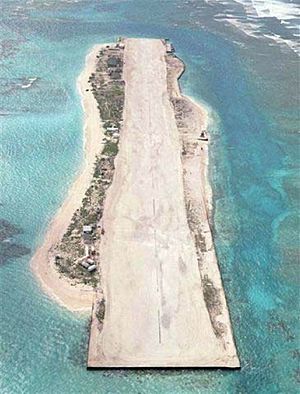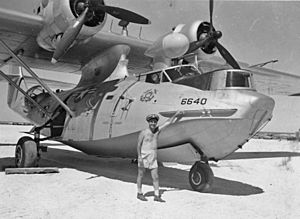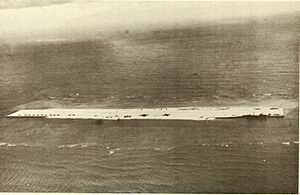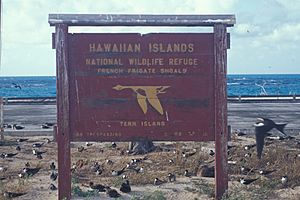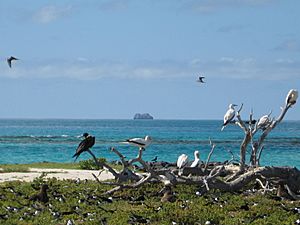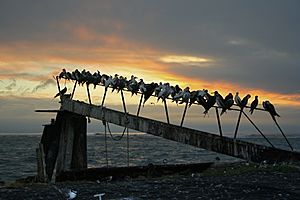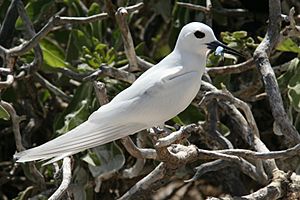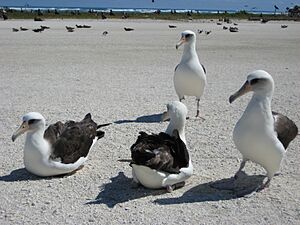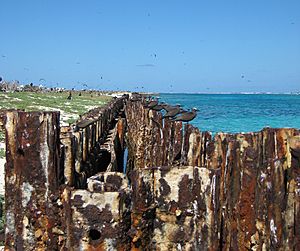Tern Island (Hawaii) facts for kids
Tern Island is a tiny coral island in the French Frigate Shoals. It's part of the Northwestern Hawaiian Islands, about 490 miles (789 km) west-northwest of Oahu. The island is small, covering about 105,276 square meters (26 acres).
Tern Island is a very important home for many animals. It's a breeding place for 18 types of seabirds. Threatened Hawaiian green sea turtles and endangered Hawaiian monk seals also live here. The United States Fish and Wildlife Service helps manage the island. It's a field station within the Hawaiian Islands National Wildlife Refuge.
The island has an airstrip that runs its whole length. It was built in 1942. This airstrip has been used by the U.S. Navy, Coast Guard, and wildlife services. It has some basic buildings for people to live and work. The U.S. Fish & Wildlife Service closed its station on the island at the end of 2012. Before that, it was a Naval base (1942-1946), a Coast Guard Base (1952-1979), and then a Fish & Wildlife station (1979-2012).
Contents
A Brief History of Tern Island
Tern Island has an airstrip that was built in 1942-1943. The Coast Guard later used it. During World War II, about 130 people worked on the island. Later, the wildlife station had between 5 and 15 staff.
After the Battle of Midway in 1942, the United States Navy built a base on Tern Island. They made the island much bigger to fit a 3,300-foot (1,005 m) landing strip. The base was mainly an emergency landing spot for planes flying between Hawaii and Midway Atoll. The original seawall, runway, and some buildings are still there.
Construction started in July 1942. The Naval Air Station officially opened in March 1943. The base was built to stop the Japanese from using nearby islands to attack Hawaii. The island grew from 11 acres to 34 acres. It had parking for 22 aircraft, a 90-foot radar tower, and barracks for the crew. Planes from Tern Island flew patrols to scout the area.
The base had defenses during World War II. These included large guns and many machine guns. After the Battle of Midway, Tern Island became a key stopping point for planes. They could refuel or make emergency landings there.
In 1944, a Curtis Commando plane had an amazing emergency landing. It had many Marines on board when one engine failed. The plane was flying very low, but it managed to land safely on Tern Island. No one was hurt.
In 1945, a U.S. Marine Corps comedy show called "All Fouled Up" visited Tern Island. Their plane couldn't land at Midway because of fog. So, they performed their show on Tern Island instead. The group later went on to Midway. They toured U.S. bases in the Pacific for two months.
The naval base operated from 1942 to 1946. A United States Coast Guard station then ran from 1952 to 1979. In 1969, a tsunami hit the island and damaged much of the station. The crew had to be rescued by helicopter and taken to Midway.
From 1961 to 1983, there was also a missile tracking station on Tern Island. Between 1986 and 1991, scientists used Tern Island to study the Green Sea Turtle.
A small plane, a Piper Aztec, has landed over 600 times at Tern Island. Flights usually go to Honolulu monthly for mail. Heavier supplies often arrive by boat. People on the island can also use email through a satellite phone or the island's internet connection.
The old U.S. Coast Guard barracks were still used in the 21st century. The island has been improved with cleaner waste systems and better water tanks. It also uses solar power. The solar power helps run a machine that makes fresh water from salty ocean water. This machine can produce 1,200 gallons of water a day. There is also a diesel generator for backup power.
In 2004, 1,200 feet of the seawall were repaired with a new design. The old boat dock was replaced with a ramp for small boats. However, many more feet of the seawall still needed repairs.
The Fish and Wildlife field station was active from 1979 to 2012. It closed after a big storm in December 2012. Several people left Tern Island before the storm hit. The storm damaged some of the buildings, including the barracks.
In 2013, Google mapped the island for a Street View project. This allowed people to see the islands online. Google and the U.S. Government worked together to show five islands in a Pacific nature reserve. This project included East Island (also in the French Frigate Shoals), Laysan Island, Lisianski Island, and Pearl and Hermes Atoll. The online viewer lets you see panoramic images as if you are walking around the island. You can see views along the airstrip and parts of the shore.
Also in 2013, the NOAA ship Oscar Sette visited the French Frigate Shoals. A tent camp was set up on Tern Island. The storm from late 2012 had made the barracks unusable. The water system also didn't work. Water had to be brought to the island in jugs from boats during this trip. Supplies were unloaded from small boats at the Tern Island dock.
In 2019, biologists did a full survey of green sea turtles on Tern Island. They found 371 green sea turtles on the island.
In 2020, the beach at Tern Island was named as polluted by plastic trash. This decision came after years of research. Over 11 years, 14,500 kilograms (about 32,000 pounds) of trash were found within 5,000 meters of the beach. More than 70 percent of this trash was plastic. This is a big worry for these Pacific islands. Scientists studied how ocean trash collects on Tern Island in the 2010s.
In 2020, the Papahanaumokuakea Marine Debris Project removed thousands of pounds of trash from the French Frigate Shoals, including Tern Island.
Birds of Tern Island
Scientists have studied how birds use Tern Island. One concern is birds eating plastic trash. This was studied on Tern Island between 2006 and 2013. Tern Island is a popular place for researchers to study Pacific sea and land birds.
About 16 different Seabird species are seen on Tern Island. Some of the birds found here include:
- Sooty terns
- White terns
- Brown noddies
- Black noddy
- Masked boobies
- Brown boobies
- Red-footed boobies
- Wedge-tailed shearwater
- Tristram's storm petrel
- Black-footed albatross
- Laysan albatross
- Great frigatebird
In 1998 and 1999, the Black-footed albatross and Laysan albatross were studied on Tern Island. The research showed that it was a difficult nesting season for the Albatrosses.
In 2010, a study noted that other rare birds sometimes visit Tern Island. Examples include a Short-eared Owl and a Fork-tailed Swift.
Tern Island also became popular with Green Sea Turtles for nesting. In 1977, there were no turtle nests on the island. But 20 years later, this grew to 700 nests!
Some shorebirds that spend the winter on Tern Island include:
The Tern Island Seawall
During World War II, the island was made larger to build the airstrip. This was done to connect with Midway and respond to Japanese actions. The island was protected from ocean waves by a 5,000-foot long seawall. This wall was made of double steel poles and finished in 1943. The original seawall from WW2 has over 5,000 steel poles. The U.S. Coast Guard also helped maintain the wall from 1952 to 1979.
In 2004, the Fish & Wildlife Service worked on a project to repair the seawall and do other maintenance. This project fixed 1,200 feet of the seawall. The U.S. Army Corps of Engineers managed this work.
Tern Island Geography
Tern Island has several beaches:
- Shell Beach & Crab Beach, on the north side
- East Beach
- South Beach
Since 2004, there has been a small boat ramp. This replaced an older dock and boat hoist.
|


